BUS502 Principles of Economics: Unfair Market Competition Analysis
VerifiedAdded on 2023/06/11
|5
|1384
|297
Report
AI Summary
This report examines unfair market competition within oligopoly markets, particularly focusing on the petrol industry. It discusses how price setting and collusion are used by major retailers to influence petrol prices, referencing an article on Perth's petrol market. The report further explains how cartels operate, illustrating the effects of such behavior on consumer and producer welfare using supply and demand analysis. It details characteristics of oligopoly markets, such as the dominance of a few key players, barriers to entry, product differentiation, and interdependence among firms. The analysis includes a discussion of various unfair market practices beyond collusion, such as mergers, acquisitions, and information asymmetry, emphasizing their detrimental impacts on market dynamics and overall welfare. This document is available on Desklib, a platform offering a wide array of study tools and solved assignments for students.
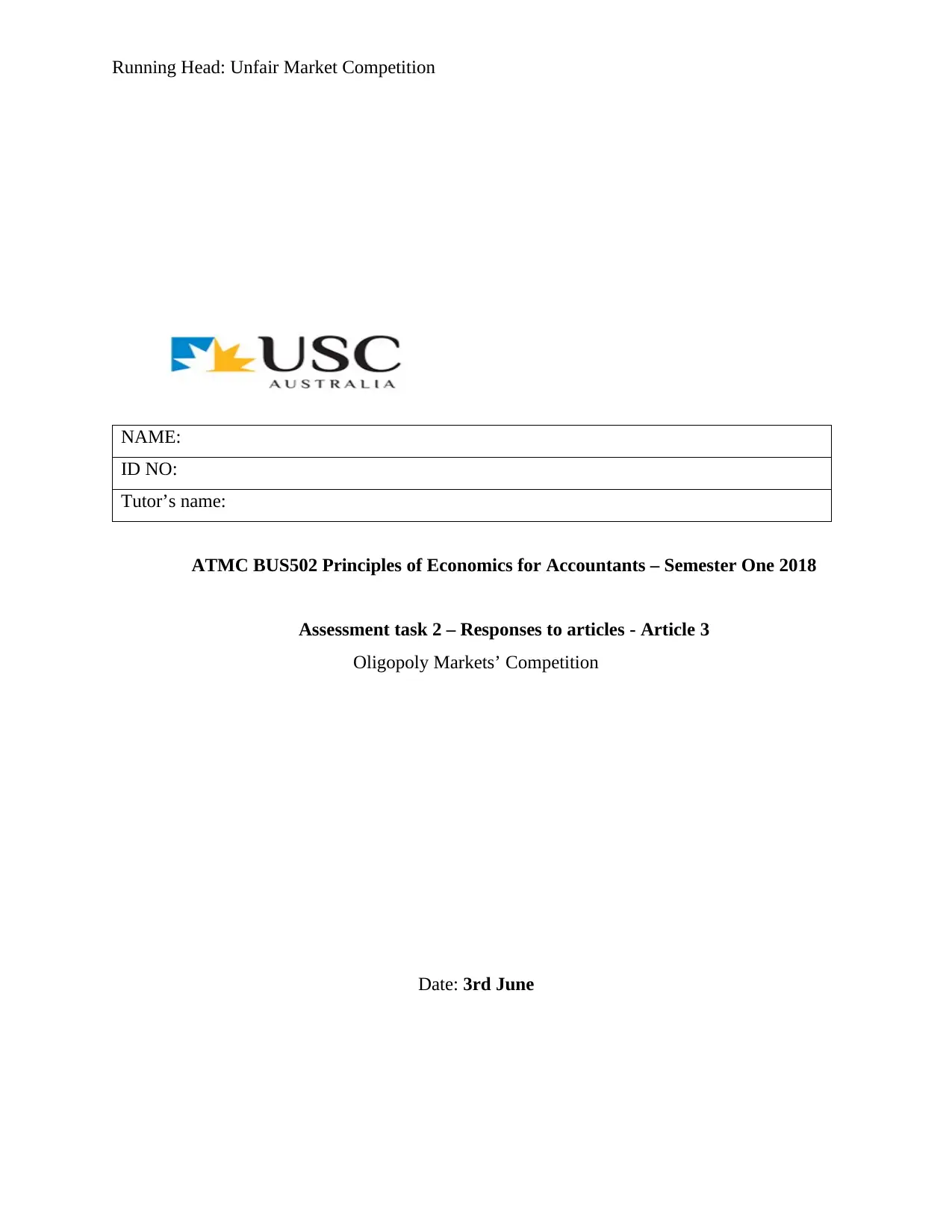
Running Head: Unfair Market Competition
NAME:
ID NO:
Tutor’s name:
ATMC BUS502 Principles of Economics for Accountants – Semester One 2018
Assessment task 2 – Responses to articles - Article 3
Oligopoly Markets’ Competition
Date: 3rd June
NAME:
ID NO:
Tutor’s name:
ATMC BUS502 Principles of Economics for Accountants – Semester One 2018
Assessment task 2 – Responses to articles - Article 3
Oligopoly Markets’ Competition
Date: 3rd June
Paraphrase This Document
Need a fresh take? Get an instant paraphrase of this document with our AI Paraphraser
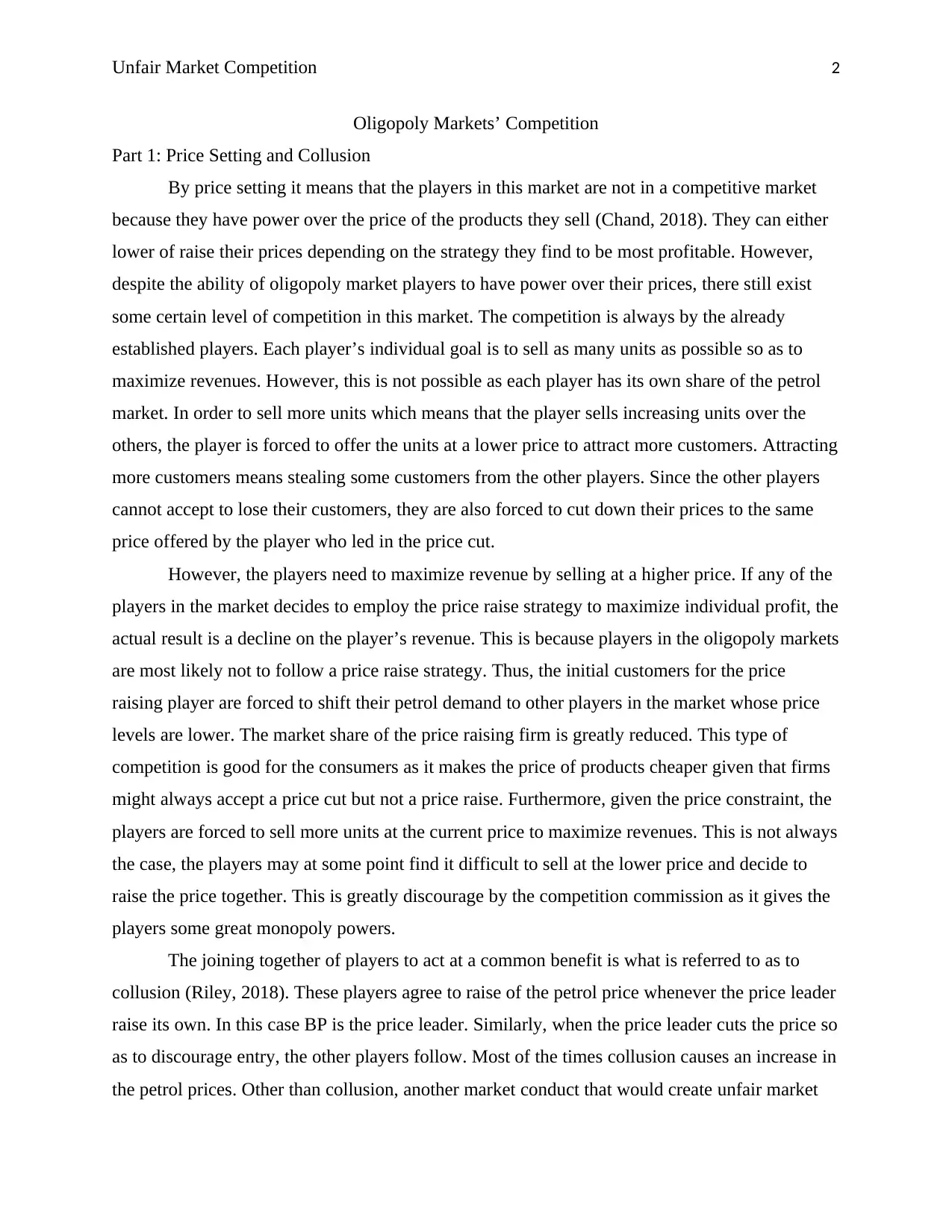
Unfair Market Competition 2
Oligopoly Markets’ Competition
Part 1: Price Setting and Collusion
By price setting it means that the players in this market are not in a competitive market
because they have power over the price of the products they sell (Chand, 2018). They can either
lower of raise their prices depending on the strategy they find to be most profitable. However,
despite the ability of oligopoly market players to have power over their prices, there still exist
some certain level of competition in this market. The competition is always by the already
established players. Each player’s individual goal is to sell as many units as possible so as to
maximize revenues. However, this is not possible as each player has its own share of the petrol
market. In order to sell more units which means that the player sells increasing units over the
others, the player is forced to offer the units at a lower price to attract more customers. Attracting
more customers means stealing some customers from the other players. Since the other players
cannot accept to lose their customers, they are also forced to cut down their prices to the same
price offered by the player who led in the price cut.
However, the players need to maximize revenue by selling at a higher price. If any of the
players in the market decides to employ the price raise strategy to maximize individual profit, the
actual result is a decline on the player’s revenue. This is because players in the oligopoly markets
are most likely not to follow a price raise strategy. Thus, the initial customers for the price
raising player are forced to shift their petrol demand to other players in the market whose price
levels are lower. The market share of the price raising firm is greatly reduced. This type of
competition is good for the consumers as it makes the price of products cheaper given that firms
might always accept a price cut but not a price raise. Furthermore, given the price constraint, the
players are forced to sell more units at the current price to maximize revenues. This is not always
the case, the players may at some point find it difficult to sell at the lower price and decide to
raise the price together. This is greatly discourage by the competition commission as it gives the
players some great monopoly powers.
The joining together of players to act at a common benefit is what is referred to as to
collusion (Riley, 2018). These players agree to raise of the petrol price whenever the price leader
raise its own. In this case BP is the price leader. Similarly, when the price leader cuts the price so
as to discourage entry, the other players follow. Most of the times collusion causes an increase in
the petrol prices. Other than collusion, another market conduct that would create unfair market
Oligopoly Markets’ Competition
Part 1: Price Setting and Collusion
By price setting it means that the players in this market are not in a competitive market
because they have power over the price of the products they sell (Chand, 2018). They can either
lower of raise their prices depending on the strategy they find to be most profitable. However,
despite the ability of oligopoly market players to have power over their prices, there still exist
some certain level of competition in this market. The competition is always by the already
established players. Each player’s individual goal is to sell as many units as possible so as to
maximize revenues. However, this is not possible as each player has its own share of the petrol
market. In order to sell more units which means that the player sells increasing units over the
others, the player is forced to offer the units at a lower price to attract more customers. Attracting
more customers means stealing some customers from the other players. Since the other players
cannot accept to lose their customers, they are also forced to cut down their prices to the same
price offered by the player who led in the price cut.
However, the players need to maximize revenue by selling at a higher price. If any of the
players in the market decides to employ the price raise strategy to maximize individual profit, the
actual result is a decline on the player’s revenue. This is because players in the oligopoly markets
are most likely not to follow a price raise strategy. Thus, the initial customers for the price
raising player are forced to shift their petrol demand to other players in the market whose price
levels are lower. The market share of the price raising firm is greatly reduced. This type of
competition is good for the consumers as it makes the price of products cheaper given that firms
might always accept a price cut but not a price raise. Furthermore, given the price constraint, the
players are forced to sell more units at the current price to maximize revenues. This is not always
the case, the players may at some point find it difficult to sell at the lower price and decide to
raise the price together. This is greatly discourage by the competition commission as it gives the
players some great monopoly powers.
The joining together of players to act at a common benefit is what is referred to as to
collusion (Riley, 2018). These players agree to raise of the petrol price whenever the price leader
raise its own. In this case BP is the price leader. Similarly, when the price leader cuts the price so
as to discourage entry, the other players follow. Most of the times collusion causes an increase in
the petrol prices. Other than collusion, another market conduct that would create unfair market
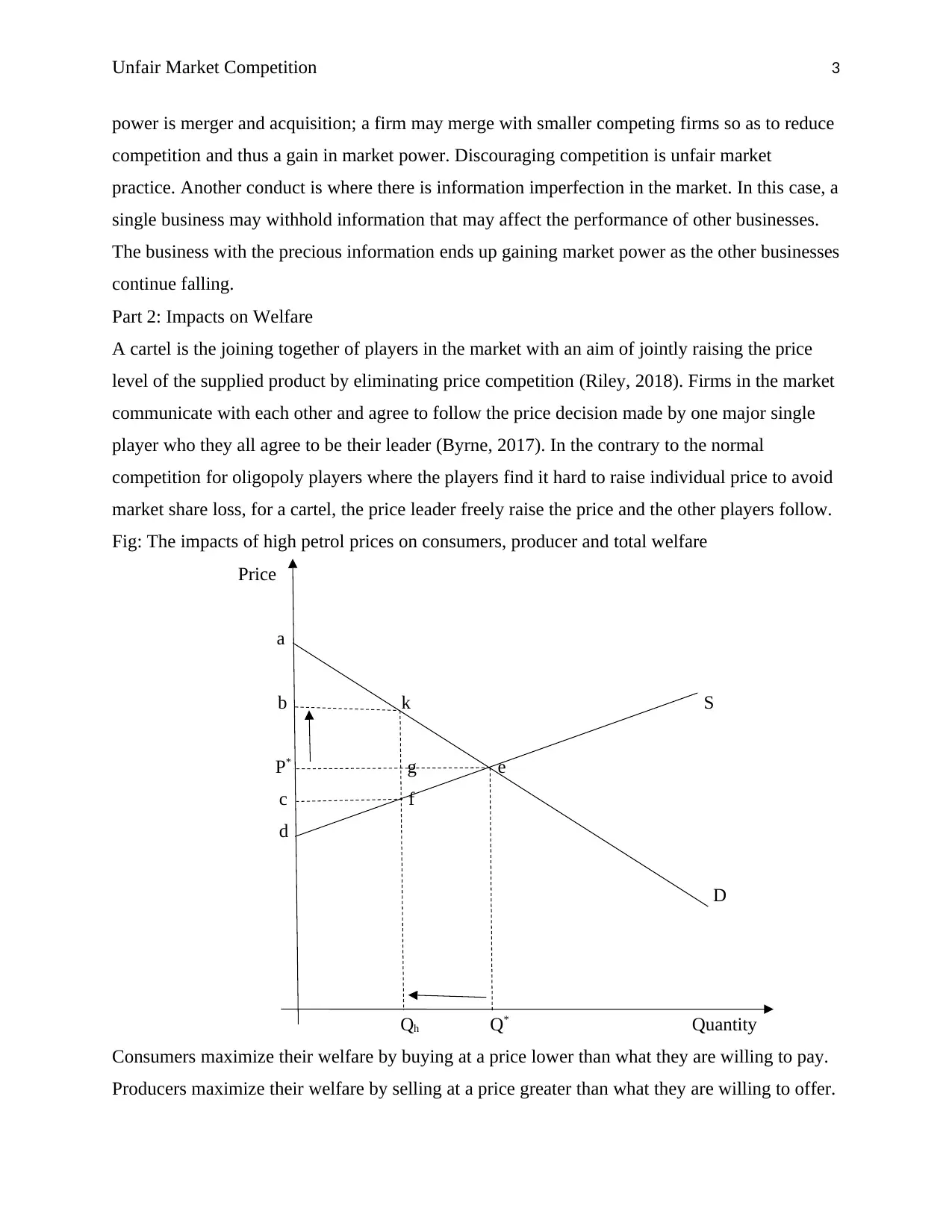
Unfair Market Competition 3
power is merger and acquisition; a firm may merge with smaller competing firms so as to reduce
competition and thus a gain in market power. Discouraging competition is unfair market
practice. Another conduct is where there is information imperfection in the market. In this case, a
single business may withhold information that may affect the performance of other businesses.
The business with the precious information ends up gaining market power as the other businesses
continue falling.
Part 2: Impacts on Welfare
A cartel is the joining together of players in the market with an aim of jointly raising the price
level of the supplied product by eliminating price competition (Riley, 2018). Firms in the market
communicate with each other and agree to follow the price decision made by one major single
player who they all agree to be their leader (Byrne, 2017). In the contrary to the normal
competition for oligopoly players where the players find it hard to raise individual price to avoid
market share loss, for a cartel, the price leader freely raise the price and the other players follow.
Fig: The impacts of high petrol prices on consumers, producer and total welfare
Price
a
b k S
P* g e
c f
d
D
Qh Q* Quantity
Consumers maximize their welfare by buying at a price lower than what they are willing to pay.
Producers maximize their welfare by selling at a price greater than what they are willing to offer.
power is merger and acquisition; a firm may merge with smaller competing firms so as to reduce
competition and thus a gain in market power. Discouraging competition is unfair market
practice. Another conduct is where there is information imperfection in the market. In this case, a
single business may withhold information that may affect the performance of other businesses.
The business with the precious information ends up gaining market power as the other businesses
continue falling.
Part 2: Impacts on Welfare
A cartel is the joining together of players in the market with an aim of jointly raising the price
level of the supplied product by eliminating price competition (Riley, 2018). Firms in the market
communicate with each other and agree to follow the price decision made by one major single
player who they all agree to be their leader (Byrne, 2017). In the contrary to the normal
competition for oligopoly players where the players find it hard to raise individual price to avoid
market share loss, for a cartel, the price leader freely raise the price and the other players follow.
Fig: The impacts of high petrol prices on consumers, producer and total welfare
Price
a
b k S
P* g e
c f
d
D
Qh Q* Quantity
Consumers maximize their welfare by buying at a price lower than what they are willing to pay.
Producers maximize their welfare by selling at a price greater than what they are willing to offer.
⊘ This is a preview!⊘
Do you want full access?
Subscribe today to unlock all pages.

Trusted by 1+ million students worldwide
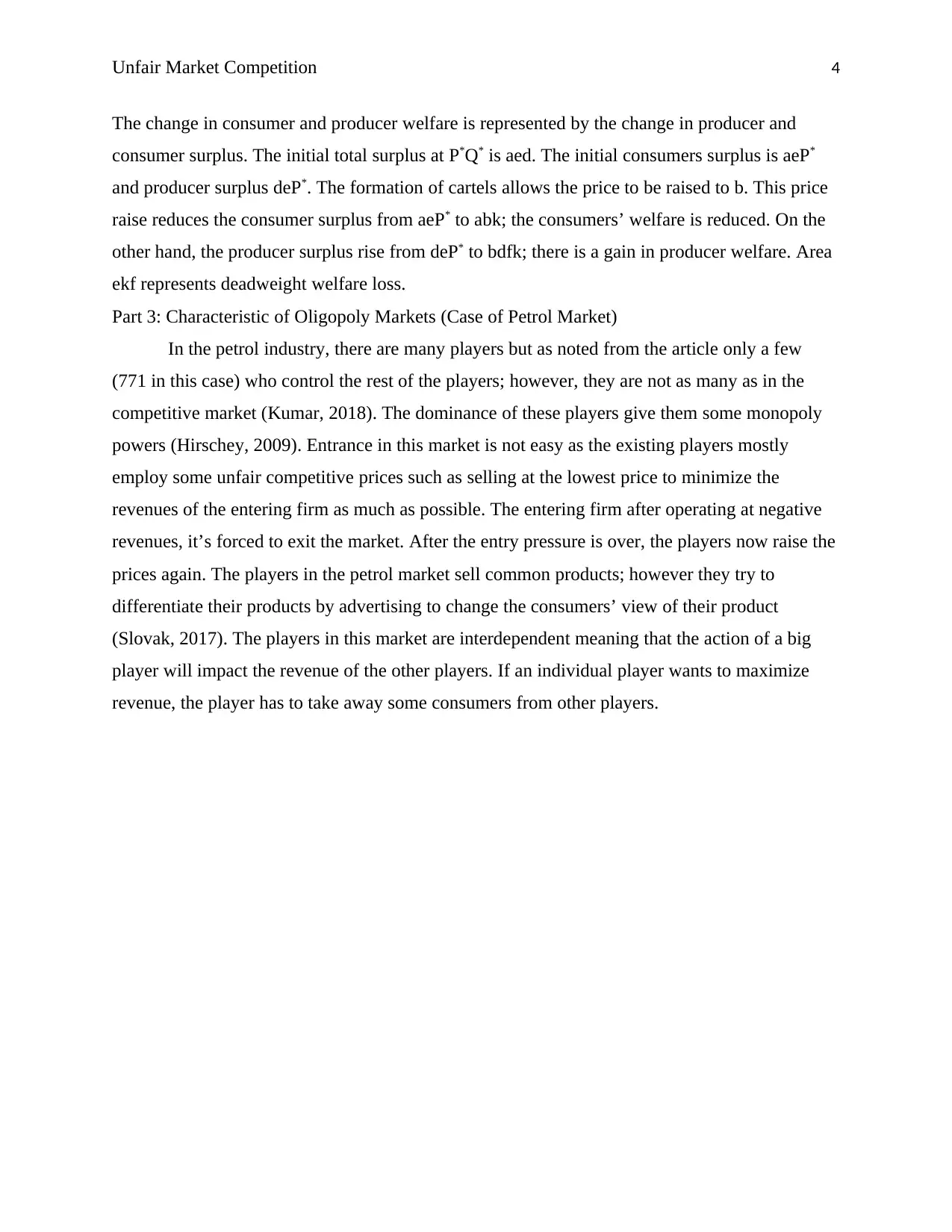
Unfair Market Competition 4
The change in consumer and producer welfare is represented by the change in producer and
consumer surplus. The initial total surplus at P*Q* is aed. The initial consumers surplus is aeP*
and producer surplus deP*. The formation of cartels allows the price to be raised to b. This price
raise reduces the consumer surplus from aeP* to abk; the consumers’ welfare is reduced. On the
other hand, the producer surplus rise from deP* to bdfk; there is a gain in producer welfare. Area
ekf represents deadweight welfare loss.
Part 3: Characteristic of Oligopoly Markets (Case of Petrol Market)
In the petrol industry, there are many players but as noted from the article only a few
(771 in this case) who control the rest of the players; however, they are not as many as in the
competitive market (Kumar, 2018). The dominance of these players give them some monopoly
powers (Hirschey, 2009). Entrance in this market is not easy as the existing players mostly
employ some unfair competitive prices such as selling at the lowest price to minimize the
revenues of the entering firm as much as possible. The entering firm after operating at negative
revenues, it’s forced to exit the market. After the entry pressure is over, the players now raise the
prices again. The players in the petrol market sell common products; however they try to
differentiate their products by advertising to change the consumers’ view of their product
(Slovak, 2017). The players in this market are interdependent meaning that the action of a big
player will impact the revenue of the other players. If an individual player wants to maximize
revenue, the player has to take away some consumers from other players.
The change in consumer and producer welfare is represented by the change in producer and
consumer surplus. The initial total surplus at P*Q* is aed. The initial consumers surplus is aeP*
and producer surplus deP*. The formation of cartels allows the price to be raised to b. This price
raise reduces the consumer surplus from aeP* to abk; the consumers’ welfare is reduced. On the
other hand, the producer surplus rise from deP* to bdfk; there is a gain in producer welfare. Area
ekf represents deadweight welfare loss.
Part 3: Characteristic of Oligopoly Markets (Case of Petrol Market)
In the petrol industry, there are many players but as noted from the article only a few
(771 in this case) who control the rest of the players; however, they are not as many as in the
competitive market (Kumar, 2018). The dominance of these players give them some monopoly
powers (Hirschey, 2009). Entrance in this market is not easy as the existing players mostly
employ some unfair competitive prices such as selling at the lowest price to minimize the
revenues of the entering firm as much as possible. The entering firm after operating at negative
revenues, it’s forced to exit the market. After the entry pressure is over, the players now raise the
prices again. The players in the petrol market sell common products; however they try to
differentiate their products by advertising to change the consumers’ view of their product
(Slovak, 2017). The players in this market are interdependent meaning that the action of a big
player will impact the revenue of the other players. If an individual player wants to maximize
revenue, the player has to take away some consumers from other players.
Paraphrase This Document
Need a fresh take? Get an instant paraphrase of this document with our AI Paraphraser
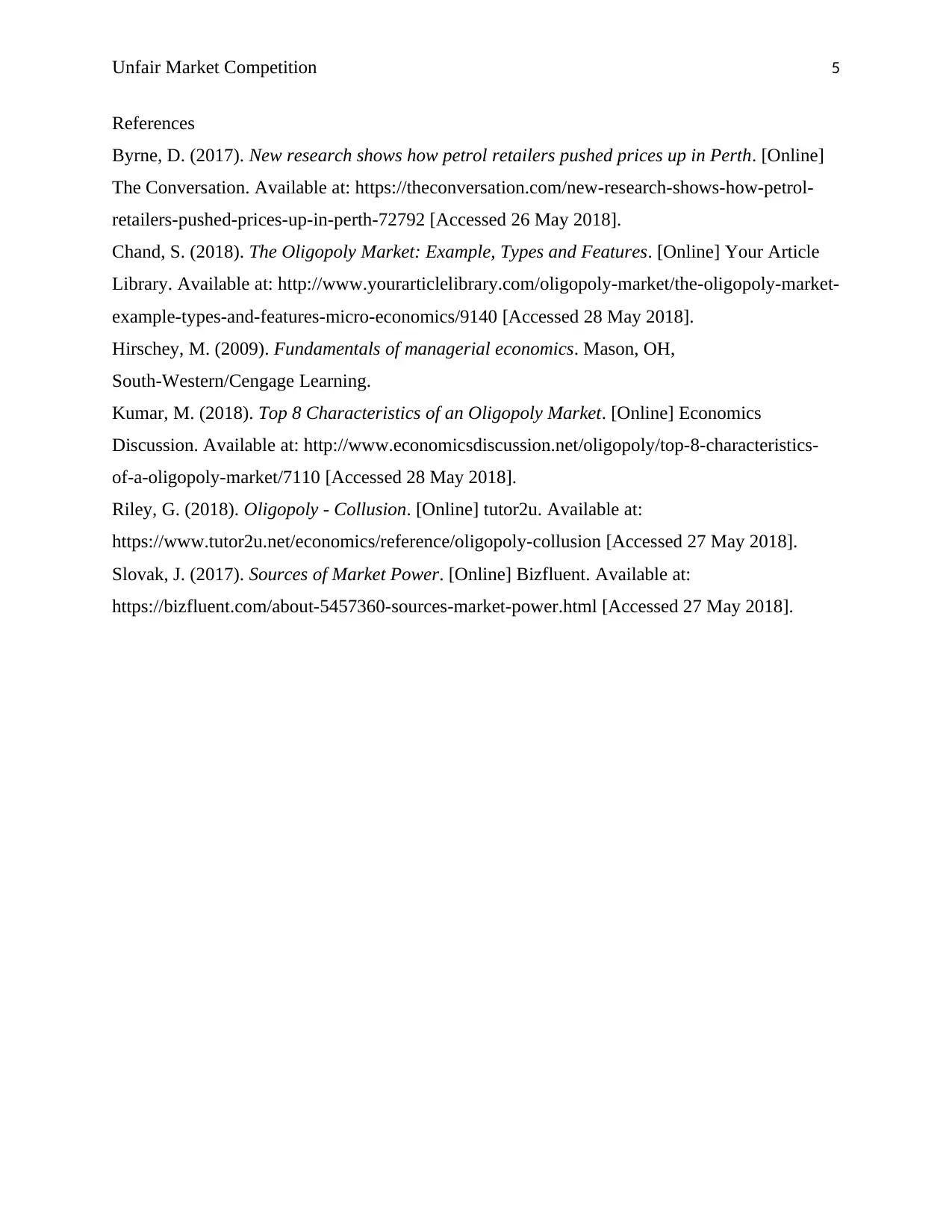
Unfair Market Competition 5
References
Byrne, D. (2017). New research shows how petrol retailers pushed prices up in Perth. [Online]
The Conversation. Available at: https://theconversation.com/new-research-shows-how-petrol-
retailers-pushed-prices-up-in-perth-72792 [Accessed 26 May 2018].
Chand, S. (2018). The Oligopoly Market: Example, Types and Features. [Online] Your Article
Library. Available at: http://www.yourarticlelibrary.com/oligopoly-market/the-oligopoly-market-
example-types-and-features-micro-economics/9140 [Accessed 28 May 2018].
Hirschey, M. (2009). Fundamentals of managerial economics. Mason, OH,
South-Western/Cengage Learning.
Kumar, M. (2018). Top 8 Characteristics of an Oligopoly Market. [Online] Economics
Discussion. Available at: http://www.economicsdiscussion.net/oligopoly/top-8-characteristics-
of-a-oligopoly-market/7110 [Accessed 28 May 2018].
Riley, G. (2018). Oligopoly - Collusion. [Online] tutor2u. Available at:
https://www.tutor2u.net/economics/reference/oligopoly-collusion [Accessed 27 May 2018].
Slovak, J. (2017). Sources of Market Power. [Online] Bizfluent. Available at:
https://bizfluent.com/about-5457360-sources-market-power.html [Accessed 27 May 2018].
References
Byrne, D. (2017). New research shows how petrol retailers pushed prices up in Perth. [Online]
The Conversation. Available at: https://theconversation.com/new-research-shows-how-petrol-
retailers-pushed-prices-up-in-perth-72792 [Accessed 26 May 2018].
Chand, S. (2018). The Oligopoly Market: Example, Types and Features. [Online] Your Article
Library. Available at: http://www.yourarticlelibrary.com/oligopoly-market/the-oligopoly-market-
example-types-and-features-micro-economics/9140 [Accessed 28 May 2018].
Hirschey, M. (2009). Fundamentals of managerial economics. Mason, OH,
South-Western/Cengage Learning.
Kumar, M. (2018). Top 8 Characteristics of an Oligopoly Market. [Online] Economics
Discussion. Available at: http://www.economicsdiscussion.net/oligopoly/top-8-characteristics-
of-a-oligopoly-market/7110 [Accessed 28 May 2018].
Riley, G. (2018). Oligopoly - Collusion. [Online] tutor2u. Available at:
https://www.tutor2u.net/economics/reference/oligopoly-collusion [Accessed 27 May 2018].
Slovak, J. (2017). Sources of Market Power. [Online] Bizfluent. Available at:
https://bizfluent.com/about-5457360-sources-market-power.html [Accessed 27 May 2018].
1 out of 5
Related Documents
Your All-in-One AI-Powered Toolkit for Academic Success.
+13062052269
info@desklib.com
Available 24*7 on WhatsApp / Email
![[object Object]](/_next/static/media/star-bottom.7253800d.svg)
Unlock your academic potential
Copyright © 2020–2025 A2Z Services. All Rights Reserved. Developed and managed by ZUCOL.





